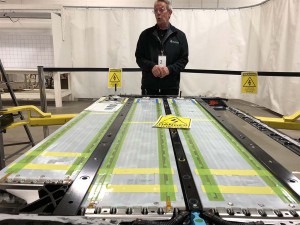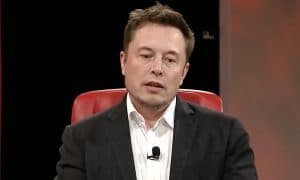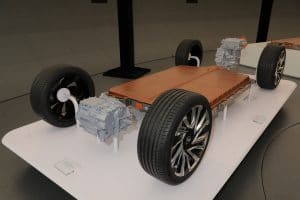Tesla may be able to boost the amount of energy it can store in its batteries by as much as 50% during the next three to four years, CEO Elon Musk suggested in a tweet.
Such a move could make battery-electric vehicles far more competitive with conventional, gas-powered vehicles than they are today by increasing range, cutting weight and potentially reducing the cost of batteries, the single most expensive part of a vehicle.
While they may be the most advanced form of batteries currently available for use in a vehicle, lithium-ion technology is far less efficient at storing energy than gasoline, typically holding less than 2% as much power in a given mass. But researchers are working on a variety of ways to boost what is referred to as “energy density,” and Musk is hinting Tesla may be close to a breakthrough.
(Nio finds way to cut EV price: don’t buy the battery.)
“400 Wh/kg *with* high cycle life, produced in volume (not just a lab) is not far. Probably 3 to 4 years,” the Tesla CEO said in a tweet. That compares with the current level of 260 Wh/kg that can be stored in the batteries – known as “2170” cells — used to power the Tesla Model 3, according to battery experts.
Exactly how Tesla hopes to get there isn’t clear, though Park Chul-wan, a South Korean battery researcher, told Reuters he believes Tesla and battery partner Panasonic are working on a technology called a “silicon nanowire anode.”
In a battery, notes Cornell University, “the anode is the negative pole during discharge and the positive pole during charge.” The cathode is its counterpart, typically at the other end of the battery.
Researchers have been working on ways to improve both of these critical parts, but it’s been especially difficult to improve anodes. They’ve been hoping to switch from conventional graphite to silicon which is far more efficient, able to store up to 10 times more electrons which would yield the sort of increase in energy density Musk referred to. The challenge has been that current silicon anodes swell and crack, especially when they deal with high levels of power, as is the case in an electric vehicle.
A silicon anode is just one of the ways battery technicians hope to improve current battery technology. Not only are they looking for ways to increase energy density but they also hope to extend the life of lithium-ion cells to the point they would last well beyond the useful life of a vehicle and, perhaps, find secondary uses in such things as backup storage on the electric grid.
(EV sales slumped during first half, even Tesla losing ground despite launch of Model Y.)
Another goal is to reduce, even remove entirely, the cobalt required in today’s batteries. It’s both a rare and toxic material and Tesla also is working with Contemporary Amperex Technology Ltd., or CATL, a Chinese battery maker that is developing cobalt-free technology.
All these moves could reduce the cost of a battery, as well, one of the biggest challenges the industry faces if it is to make electric vehicles competitive.
Tesla is by no means the only company targeting better batteries. General Motors says it will achieve a number of key goals with the new Ultium cells it plans to build at a new factory in Ohio as part of a joint venture with South Korea’s LG Chem. They will use significantly less cobalt than the batteries in the current Chevrolet Bolt EV, have a higher energy density and be significantly cheaper, the partners claim.
When the Bolt debuted, its 66 kilowatt-hours of batteries cost $9,570, or about $145 a kWh. The target is around $100 for Ultium cells, said GM’s battery chief Tim Grewe, but the automaker hopes to get that down as low as $70.
Meanwhile, work is underway on what could become an entirely new type of battery known as “solid state.” It replaces the slush inside a cell with a ceramic substrate that, proponents claim, will be cheaper, more durable and more powerful. But the technology isn’t expected to reach production until the second half of this decade – if it proves viable in practical applications.
(Lucid claiming 517 mile range for Air EV.)
As for Tesla, the automaker may have more to say about where its own technology is heading next month at its annual “Battery Day.” The event is normally a crowded on but Tesla will hold a lottery this year and permit only a small number of attendees on Sept. 22 due to the coronavirus pandemic.




